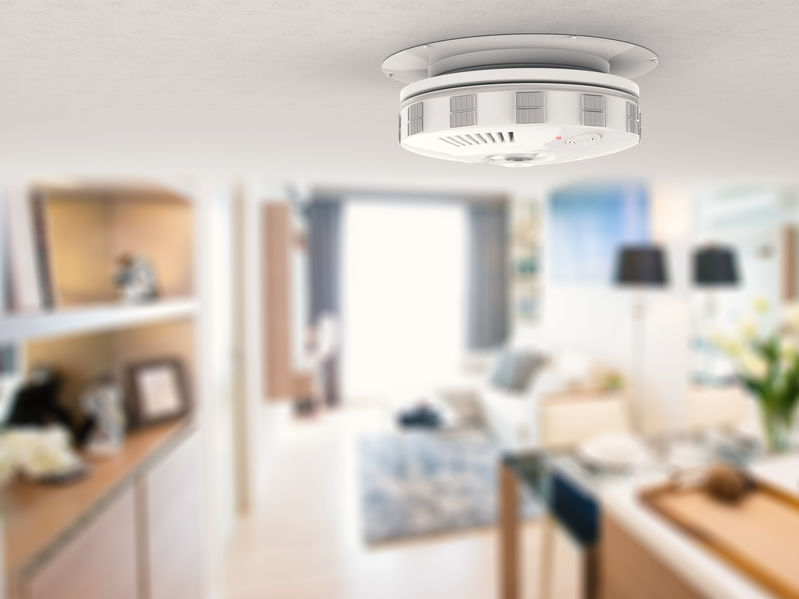Smoke Alarms
On a basic level, smoke alarms work by alerting you to smoke in the home. Although, these devices can create nuisance alarm situations from sources such as smoke emanating from your fireplace and/or wood burning stove. Other situations occur from alarms triggered by smoke or steam coming from the kitchen or bathroom.
Smoke alarm manufacturers have realized some of these flaws and have made design changes to address these nuisance alarms. You can buy “Bedroom” alarms designed to be placed in all bedrooms, “Hallway” alarms which light up the hallway in an alarm situation to guide your path, and even a “Kitchen” alarm that has been desensitized to normal cooking situations. You can also buy alarms that combine smoke and carbon monoxide detection in one unit.
One of the best features that I have found with these newer alarms is the hush feature. We have all had alarms go off when the toast burns or the fireplace is lit and we find ourselves fanning the alarm with a towel or newspaper. All you have to do now is to press the hush button and it silences the alarm for 10 minutes which gives you enough time to clear the smoke or other alarm situation. The older 9-volt battery operated alarms will start chirping when its time to change the battery. The problem with those are that sometimes they are so high up, you can’t even reach them with the ladder on hand.
In some cases, you may have to knock it off the wall or ceiling with a stick or broom to get it down and to silence the annoying sound. When this happens and you don’t have the right battery on hand, it often finds its way into a drawer never to be seen again.
The hardwired alarms are great because they will always be powered as long as your electricity is on. These also have a backup battery but the same chirping situation can happen when you’re alerted to change the backup battery.
Smoke alarms typically need to be changed out after 10 years. Newer alarms now have a sealed lithium ion battery that lasts for 10 years and is not replaceable. There are a couple of ways to check out how old your smoke alarm is. The manufacturers include a label right on the alarm so the installer can note the installation date and it is usually visible without removing the alarms. Another way is to twist the alarm counter-clockwise to remove it and the manufactured date is often listed on the main label.
One thing to mention…a hardwired alarm is powered using one of the full house voltage circuits in your home (120 volts). These should only be replaced by someone knowledgeable in working with high voltage systems as one mistake with electricity could be your last. When you’re checking the batteries or install date on a hardwired alarm and twist it counter-clockwise to remove it, if it has wires dropping down through the ceiling, it is hardwired. Don’t unplug it or undo the wiring harness unless you know what you are doing.
Additionally, there are smart alarms that can be ran from Alexa or Google assistant. These devices will be covered in a separate blog about smart devices and smart home systems. If you have any questions on these types of devices, feel free to reach out to me and I’ll be happy to answer any questions pertaining to those devices and how they work or are setup.
Carbon Monoxide Alarms
Carbon monoxide alarms are similar to smoke alarms but instead of alerting you to smoke, they alert you to the presence of carbon monoxide which is an odorless, colorless gas that can kill you. In fact, one of my uncles died from when I was 5 years old due to carbon monoxide poisoning that happened in the trailer he was living in. Fortunately, he died peacefully in his sleep.
Although, this is a tragedy that happens to many Americans every year and it is preventable by installing carbon monoxide alarms or making sure that your current ones are up to date. Carbon monoxide can be produced from many sources including vehicle exhaust, small engines including generators, fireplaces, furnaces, cigarettes, stoves, lanterns, grills, and gas ranges.
It is recommended to install carbon monoxide alarms on every level of your home and close to sleeping areas.
Here are some preventative measures to reduce the risk of carbon monoxide build up in your home:
- Have your chimney or wood burning stove flu checked every year
- Don’t run generators or portable gas stoves indoors (I’ve seen many generator setups in garages – Note: open the garage door when running the generator)
- Use proper ducting tape when sealing a vent pipe from a gas burning appliance such as a gas water heater
- Don’t use a gas range to provide heat in your home, especially in a small trailer
- Don’t burn charcoal indoors
Contact Me for a Free Quote
This is a general overview of the safety that smoke and carbon monoxide alarms can provide. They can alert you and your family to potential problems and safety issues that may arise. They can even save your life which is what they were designed to do. If you have any additional questions on smoke and carbon monoxide detectors in Los Gatos, CA, please contact me directly at (408) 314-7645 or submit a free quote request on my website. I’ll be happy to answer any questions you may have.



